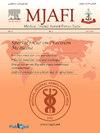Process improvement in automated blood cultures: Our road to better patient care
Q2 Medicine
引用次数: 0
Abstract
Background
Blood cultures (BC) are a complex multistep process susceptible to errors at multiple levels. Our study was conducted to monitor the compliance to standard operating procedures, design an intervention plan for improvement and monitor the impact of the intervention. The study design focuses on the intervention.
Methods
A hospital-based prospective interventional study was carried out, monitoring various pre-analytical, analytical, and post-analytical factors in two phases. Our interventions focused on communication and training for the deficiencies noted in completeness of test request form, contamination rates, and sample loading interval.
Results
Comparison between both phases showed a statistically significant improvement (p < 0.05, Chi square test) following our interventions in the completeness of test request form, contamination rates and sample loading interval. There was an improvement in the intimation of critical Gram stain from positive flagged bottles, which was not statistically significant.
Conclusion
Our study highlights how educational interventions can influence quality of BC. Continuous monitoring and interventions are key for quality improvement in BC processes.
自动化血液培养的流程改进:改善患者护理之路
血液培养(BC)是一个复杂的多步骤过程,容易在多个层面上出现错误。我们的研究是为了监测对标准操作程序的遵守情况,设计一个改进的干预计划,并监测干预的影响。研究设计的重点是干预。方法采用以医院为基础的前瞻性介入研究,分两个阶段监测分析前、分析中和分析后的各种因素。我们的干预措施侧重于沟通和培训测试申请表完整性、污染率和样品加载间隔方面的缺陷。结果两期比较均有统计学意义(p <;0.05,卡方检验)在测试申请表的完整性,污染率和样品加载间隔方面进行了干预。阳性标记瓶的临界革兰氏染色提示有所改善,但无统计学意义。结论本研究强调了教育干预对BC质量的影响。持续监测和干预是BC过程质量改进的关键。
本文章由计算机程序翻译,如有差异,请以英文原文为准。
求助全文
约1分钟内获得全文
求助全文
来源期刊

Medical Journal Armed Forces India
Medicine-Medicine (all)
CiteScore
3.40
自引率
0.00%
发文量
206
期刊介绍:
This journal was conceived in 1945 as the Journal of Indian Army Medical Corps. Col DR Thapar was the first Editor who published it on behalf of Lt. Gen Gordon Wilson, the then Director of Medical Services in India. Over the years the journal has achieved various milestones. Presently it is published in Vancouver style, printed on offset, and has a distribution exceeding 5000 per issue. It is published in January, April, July and October each year.
 求助内容:
求助内容: 应助结果提醒方式:
应助结果提醒方式:


